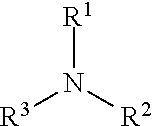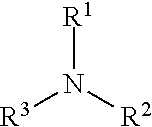Gasoline fuel composition for improved performance in fuel injected engines
- Summary
- Abstract
- Description
- Claims
- Application Information
AI Technical Summary
Benefits of technology
Problems solved by technology
Method used
Image
Examples
##ventive example 1
Inventive Example 1
[0033]A polyisobutylene succinimide (PIBSI) detergent was prepared by reaction of polyisobutylene succcinic anhydride (PIBSA) with dimethylaminopropyl-amine (DMAPA) by a well known method, such as the modified procedure of U.S. Pat. No. 5,752,989. The resulting PIBSI (200g, 78 wt. % in an aromatic solvent) was combined with 17.8 grams of sodium chloroacetate (SCA), 81 grams of deionized water, 58 grams of aromatic solvent, and 76 grams of isopropanol and heated at 80° C. for 2.5 hours, then at 85° C. for 1 hour. The reaction product was extracted with heptanes and the heptanes layer was washed with water five times to remove sodium chloride from the reaction product. Volatiles were removed from the reaction product under reduced pressure to give a salt product that was a brownish oil.
##ventive example 2
Inventive Example 2
[0034]The reaction product was made similar to that of Inventive Example 1, except that the 950 number average molecular weight PIBSA was replaced with 1300 number average molecular weight PIBSA and the reaction mixture was mixed with toluene to remove water by azeotropic distillation and the resulting product was filtered using a diatomaceous earth filter rather than extracted with heptanes in order to remove sodium chloride from the reaction product. Volatiles were removed from the reaction product under reduced pressure to give a salt product that was a brownish oil.
##ventive example 3
Inventive Example 3
[0035]The reaction product was made similar to Inventive Example 2 with the exception that the 1300 number average molecular weight PIBSI was replaced with oleylamido propyl dimethylamine (OD). The reaction product was mixed with an aromatic solvent and 2-ethylhexanol to provide a yellow liquid.
PUM
 Login to View More
Login to View More Abstract
Description
Claims
Application Information
 Login to View More
Login to View More - R&D
- Intellectual Property
- Life Sciences
- Materials
- Tech Scout
- Unparalleled Data Quality
- Higher Quality Content
- 60% Fewer Hallucinations
Browse by: Latest US Patents, China's latest patents, Technical Efficacy Thesaurus, Application Domain, Technology Topic, Popular Technical Reports.
© 2025 PatSnap. All rights reserved.Legal|Privacy policy|Modern Slavery Act Transparency Statement|Sitemap|About US| Contact US: help@patsnap.com



